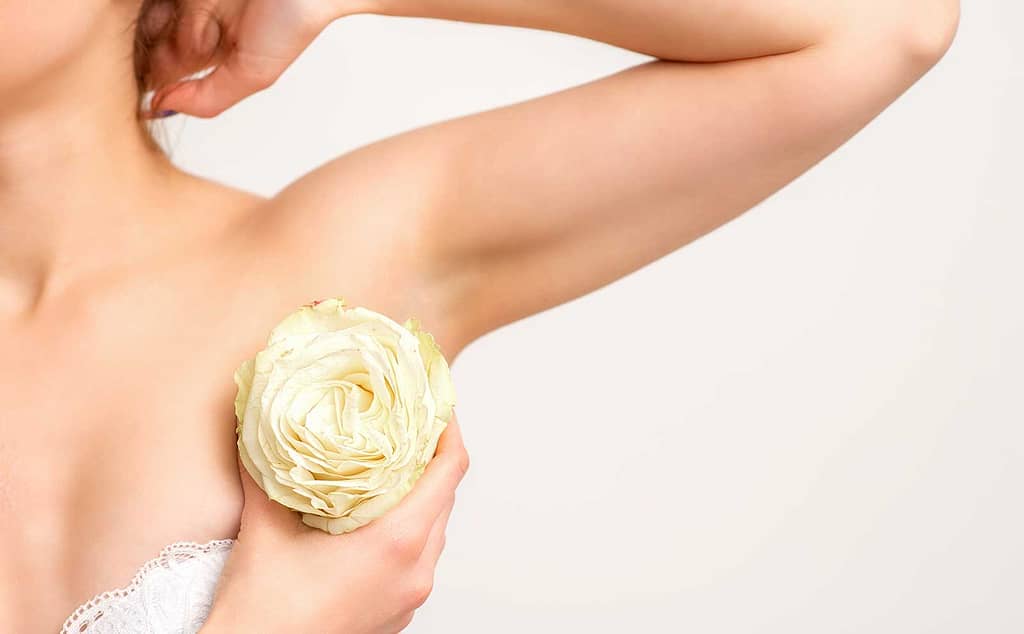Have you ever put on one of your favorite shirts only to realize that there are sweat stains on the underarms? This is embarrassing if you didn’t take note of the situation before you left the house. Still, it’s also irritating when some of your favorite articles of clothing are potentially ruined by something as normal as sweating.
If you read the following chapters, you’ll notice that we have a number of ways that you can learn how to get sweat stains out of shirts. We’ll also talk about why this occurs and what you can do to prevent it. Say goodbye to those annoying sweat stains for good!
Prevention & care
Sweat stains can completely ruin a piece of clothing. It’s more common to experience these stains on light-colored clothing, but it can happen with any item. Preventing this situation will keep your clothes looking nice. Knowing how to care for sweat stains will help you avoid throwing out some of your favorite shirts.
Dressing for the weather is something that we take into account when we choose our outfits in the morning. We don’t want to be overdressed if it’s hot outside and cold weather warrants some additional clothing.
However, there will be times when you get hot and sweat in your clothes. This has to do with the temperature outside, but you may also notice that the interior temperature of a building affects how you feel.
What do you do when you sweat and end up with sweat stains on your shirt? We’re going to talk about preventing this from happening in this chapter, as well as what you should do about those pesky stains.
Why does sweat stain?
Most people’s sweat doesn’t have a color, but sweat has the ability to stain clothing once it has saturated a piece of fabric and the sweat has set in. Most stains end up looking yellow or gold in color, and you may not notice them until later on when you’ve taken off your clothing, or it’s already been run through the washer and dryer.
The cause of sweat stains is sometimes the sweat itself. Other times, this problem presents itself because of the products that you’re wearing. Most antiperspirants contain salts such as aluminum chloride, aluminum chlorohydrate, or aluminum zirconium.
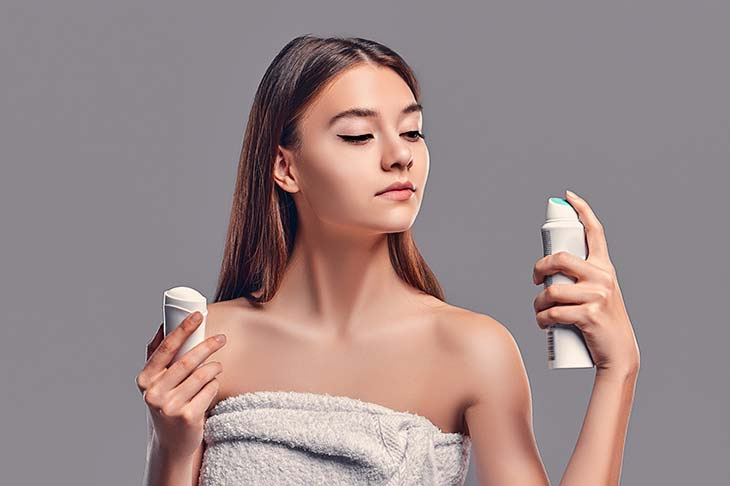
When these salts interact with the electrolytes that are in your sweat, this can cause marks to appear on the clothing that’s touching the area. White clothing may turn yellow. Dark clothing can end up with white, salty stains. If you’re lucky, your dark clothing will hide the stains much better, so you don’t even know that they’re there.
In some rare cases, there is a condition called chromhidrosis which will cause people to have yellow, blue, or green sweat. While you don’t see this a lot, this condition can cause staining on clothing. If you have this issue, you’ll want to have a good washing process in place that addresses potential stains before they set in permanently.
Prevention tips and tricks
If you know that you’re prone to sweat stains on your shirts, you’ll want to come up with a routine for treating your clothing and washing it properly. This will ensure that sweat is washed out of the clothing so that it doesn’t leave behind discolored stains that ruin the appearance of your wardrobe. Let’s take a look at some prevention tips and tricks that will help you deal with potential sweat stains.
Don’t apply too much deodorant
Earlier on in this article, we talked about the potential for deodorant to cause a reaction between your body and the deodorant, which would leave behind stains on your clothing. That doesn’t mean you have to avoid deodorant altogether since it can help keep you smelling fresh even if you are sweating.
The goal is to wear a minimal amount of deodorant. Apply a thin layer under your arms and let it dry before putting your shirt on in the morning. If you notice that you need more later in the day, you can reapply to dry armpits. Keep an extra stick in your bag for this purpose. Don’t put so much product on that it’s seeping into your clothing before you’ve even left the house for the morning.
Wear an undershirt
A great way to protect your nice shirts is to wear an undershirt. The undershirt can be washed, but you can also replace the shirts as needed, and it’s much more affordable than replacing all of your dress shirts. Cotton undershirts absorb sweat nicely, and they’re not very prone to changing color because of sweat. You can wash them using bleach if there are any stains to address, and you can pre-treat the shirts before putting them into your washer.
Wear antiperspirant
There is a big difference between an antiperspirant and a deodorant product. Deodorants are designed to prevent bacteria in your sweat from making you smell. They usually contain an ingredient like baking soda, which will neutralize any odors that occur.
When you put on an antiperspirant, the product will be absorbed into the pores that are located under your arms. The sweat will not be able to leave your body due to salts in the product that halt the sweating process.
If you’re someone that sweats excessively, then this type of product will keep you smelling fresh but also prevent sweat stains on your shirts.
Wash your clothes before sweat dries
Sweat is a lot like any other foreign substance that gets onto your clothing. If you get spaghetti sauce on a white shirt, the goal is to get the sauce off the material right away, so the stain doesn’t set. Sweat works the same way.
If you let the sweat get absorbed into the material, and then it dries, it makes it more difficult to wash it out. When you get home, take your shirt off and begin the process of treating it and washing it. Don’t throw it in the hamper where it will sit for a day or two, creating a bigger problem to deal with later on.
Apply some lemon juice and water before treating the stain
There are plenty of stain-removing products that you can utilize to treat your clothing, but there are also home remedies that you can use to treat stains. Squeeze a little bit of lemon juice into a bowl and mix in the same amount of water. Apply the mixture to the sweat stain before you wash it. The lemon juice should help to neutralize the stain and loosen it from the fabric.
Pay Attention to What You Wear
The clothing that you wear should be loose-fitting and breathable. Stick with natural materials that don’t trap heat. If you don’t have anything tight on that’s fitting right up against your skin, the sweat will be more likely to dry under your arms before it has the ability to soak into the fabric. It also helps to dress in layers. You can remove a layer of clothing if you start to get warm and begin to sweat.
Pick the Right Detergent
If you’re prone to sweat stains on your clothing, choose a detergent that has stain-fighting power. Surfactants and bleaching agents are commonly used ingredients that help to remove stains from clothing. It’s best to wash your clothes in cold water. Warm or hot water helps the stain set into the fabric, which is what you’re trying to avoid.
Skip the Ironing

If you put your clothing through the wash and notice that there is a sweat stain still present, don’t iron the clothing anyway. Applying heat to that area will cause the stain to set in further. Repeat the process of treating the stain and washing it in your washing machine. You may have to do this a few times to get the stains completely out.
Talk to Your Doctor
Some people have conditions that cause excessive sweating. Over-the-counter products just don’t cut it when it comes to preventing odor and controlling moisture. There are clinical-strength products that you can acquire from your doctor that will address your issue, and there are even treatments that you can use to reduce the amount of sweat you experience each day. This includes nerve-blocking medications, injections, and much more.
If all else fails, you may need to turn to a professional that can help you remove the sweat stains. If you’re dealing with delicate fabrics like lace or silk, it’s best to avoid attempting to clean the stain at home. You can end up doing more harm than good. You may be able to remove the stain, but you could end up damaging the fabric to the degree that it becomes ruined.
Now that you are knowledgeable about sweat stains and how to prevent them on your clothing, you can make some changes to your routine that will keep your clothes looking and smelling fresh.
The goal is to address the problem, so sweat stains don’t become a common issue that results in having to constantly replace clothing or sport unattractive stains on your favorite shirts.
Coming up next in the following chapters, we’re going to talk about getting sweat stains out of your clothing in addition to removing deodorant stains that are present.
How to get sweat stains out of shirts
We’ve talked about preventing sweat stains on your clothing, but there will be times when you don’t notice that sweat has set into some of your shirts while you’re wearing them. Don’t worry, there are some things that you can try to remove the stains from your clothing so your shirts aren’t a total loss.
Whether you like it or not, sweat stains may be something that you have to deal with if you’re someone that perspires quite a bit on a regular basis. Even the best antiperspirants and deodorants don’t always do their job on a very hot day. Sweating is a fact of life, and it’s just something we have to deal with. If it gets onto your clothes, it’s not the end of the world.

Luckily, it’s possible to get rid of sweat stains with the help of a few tips and tricks. The methods that you find successful will really depend on how bad the stain is. You can try multiple methods until the stain has been completely removed. Don’t toss out that clothing just yet! Let’s get started with some of these tried and true stain removal processes.
White shirts
by Assembled Style
A white shirt will show sweat pretty easily, and the color will usually be yellow or gold. These stains occur from the sweat itself, but there may also be a reaction that occurs between your sweat and the deodorant or antiperspirant that you’re wearing. White shirts can be hard to treat, but there are some steps you can take to try and remove the discoloration.
Rinse the garment in cold water
It’s always a good idea to rinse the sweat out of your clothing using cold water. Hot or warm water will cause the oils in the sweat to set into the fabric further. Cold water will provide a good rinse that will hopefully remove the bulk of the stain before proceeding with washing the fabric.
You should rinse the garment as soon after wearing it as you can. If you let the sweat sit on the fabric for a long time, this results in the stain becoming more severe and pronounced. It will be harder to get it out.
Pre-treat the sweat stain with white vinegar, baking soda, detergent, or hydrogen peroxide
You don’t want to just throw your clothing right into the washing machine. You should always pre-treat the stain, letting your stain-fighting ingredients do their job for a bit before you attempt to wash anything out.
There are a number of ingredients and products you can use to pre-treat your sweat stains, including white vinegar, baking soda, detergent, and hydrogen peroxide. Hydrogen peroxide can bleach fabric, so make sure you’re only using it on white clothing. It’s a good idea to let these products sit on your clothing for at least a couple of hours before washing your clothes.
Let it sit for a while
You don’t want to let stains set into the fabric for too long before taking care of the issue. However, getting a stain-fighting product or ingredient onto your clothing and letting that sit on the fabric is ideal.
This process allows the stain to loosen up on the fabric. When you eventually go to wash the item, the stain should come out a lot easier than if you just tossed it in the washer, to begin with.
Wash the garment with detergent
If you’ve traveled down the laundry detergent aisle in your grocery store lately, then you know how many different products there are available for washing your clothes. How do you know which one to pick if you have sweat stains to contend with? Look for a detergent that has stain-fighting ingredients in it.
If you’re washing white shirts, you can also choose a product that contains bleach. Colored clothing should have color-safe bleach in it, so it doesn’t ruin the colors of the clothing. Follow the instructions on the detergent you choose regarding water temperature, soak time, etc.
Repeat the process if the stain persists
You may find that your sweat stains don’t come out the very first time that you treat and wash them. Don’t be afraid to repeat the process you used a few times if you notice that the stains persist. It’s not a total loss if you don’t notice a difference right away. It can take a couple of washings to really see that stain start to fade.
Once clean, let it dry
Before you determine if the stain needs to be treated and rewashed, let the item dry. It may look like the stain is gone, but you can’t really tell until all of the moisture is gone from the shirt.
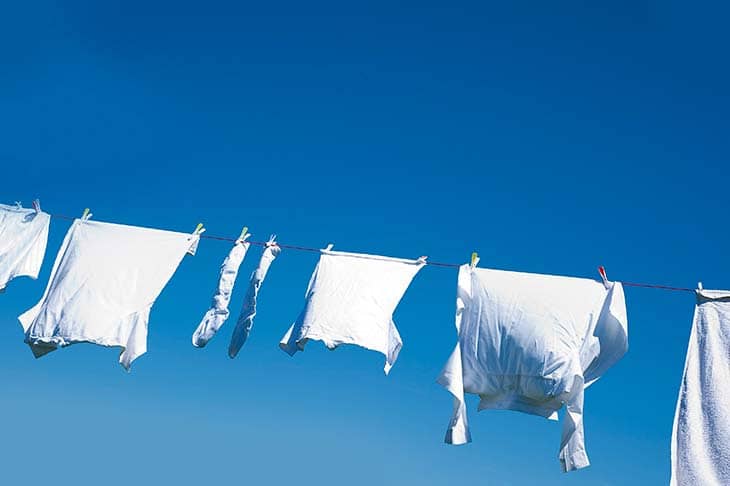
It’s already been washed once, so it’s not going to make a big difference if you let the clothing air dry for a few hours before washing it again. You may notice that the stain is completely gone, which means you can iron your clothing and start wearing it again.
Soak Clothing in the Washing Machine
Most modern washing machines have a setting that allows you to soak your clothing in the machine for a preset amount of time. If your washing machine has this feature, utilize it for your sweat stains.
Fill the machine with the detergent you’re using, set it to cold water, and set the soak timer for at least 15 minutes. This gives your detergent and any stain fighters that you used plenty of time to get into the fibers of your shirts.
Use Cold Water in Your Washing Machine
We talked about rinsing your stain with cold water, but you should also be using cold water in your washing machine. Most detergents are designed to work with cold water to remove the stain rather than forcing it to set in further.
Never Run the Clothes through the Drier Before You Confirm the Removal of the Stain
Keep your clothes out of the dryer if you’re unsure if the stains have been removed. The heat from the dryer will make the issue worse if you’re going to need to retreat the items and rewash them.
Colored shirts
Dealing with sweat stains on colored shirts can be a different process than when the stains are present on white shirts. The cause of the stain is usually different, which can alter the removal process. Let’s take a look at some tips and tricks you can use to remove sweat stains from colored shirts.
Rinse the colored shirt/garment in cold water
As with white shirts, you’ll want to rinse the sweat stain out of your shirt using cold water. The nature of the stain on your colored shirt is a bit different than what’s going on with the white fabric. Sweat on white fabric can turn yellow. The stains you see on your colored shirts are usually from the deodorant or antiperspirant that you’re wearing under your arms.
Pre-treat the stained area with white vinegar or detergent
Vinegar or detergent applied to the stain prior to washing is a great way to tackle the stain before it becomes a bigger problem. This is a pre-treatment that takes your washing to the next level. White vinegar can help to neutralize the stain before the detergent will do its job. Let everything sit on the fabric for about an hour or two before proceeding.
Let stain treatments sit for about 20 min
If you’ve applied a stain treatment product, let it sit on the fabric for about 20 minutes before you continue with the next step of the process. You may need to leave it on longer, so refer to the instructions on the product you’ve chosen. Natural remedies like vinegar or lemon juice may need to sit on a bit longer for the best results (one to two hours).
Throw the garment into the wash without removing the pre-treatment detergent
You don’t want to remove the pre-treatment from the fabric prior to putting the garment in the washing machine. Let it remain on the fabric as long as possible as it runs through the wash cycle.
Check the label and wash it with other clothes
You don’t have to wash your stained items separately. Just check the label so you’re following the appropriate washing process, and keep your clothing sorted by color, so nothing else gets ruined. For example, keep your white shirts out of your colored load of wash.
Let it Air Dry
Let your clothing air dry before you assess the stained area. If you let it run through the drier, this is going to cause the stain to set further if it’s not completely gone.
You’re now an expert at removing sweat stains from your shirts! Stick with us to learn more about removing deodorant stains and severe sweat stains on the underarms of your shirts.
How to remove deodorant stains from shirts
Deodorant does an excellent job of keeping our sweat from making us smell, but there is often a price to pay with many of these products. The different oils and ingredients in deodorant can end up staining clothing while in the process of keeping us fresh.
If you don’t take care of your shirts properly, stains can set in and ruin the material. In this chapter, we’re going to be talking about what causes sweat stains and what we can do to remove them.

You’re getting ready to go out. You pick out your favorite outfit and go to get dressed. Before you walk out the door, you realize that your shirt has big stains on the underarms. It was recently washed and dried, so what happened? Those spots are caused by deodorant that you had on the last time you were wearing that shirt.
by How2RemoveStains
You probably didn’t notice they were there, and you went ahead and laundered the shirt. You may still be able to salvage that article of clothing, but you should also be careful of this situation occurring again in the future.
Before you throw away your deodorant and refuse ever to wear it again, we want to share some tips for you regarding getting sweat stains out of your clothing. You will also learn how to treat and prevent these stains, so there’s nothing to stress about in the future.
What causes deodorant stains on clothing?
Sweat has the ability to stain your clothing, but deodorant can do the same thing. If your deodorant is also an antiperspirant, your sweat may be reacting to the aluminum salts that are in that product.
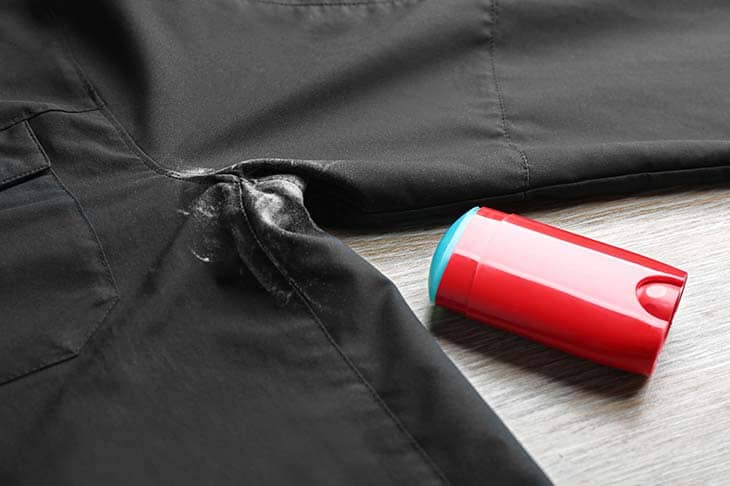
You can also accidentally get the product right onto your clothing, causing a stain to form (especially on dark clothing). If you’re wearing something light in color and the reaction occurs, you may notice that the stains are yellow in color.
Many people have switched to more natural deodorants that contain healthier ingredients. While ingredients like shea butter, coconut oil, and baking soda work wonders to neutralize odors, they can also leave behind some unsightly marks.
You may want to switch your deodorant to make it less likely for stains to occur, especially if you’ve been experiencing a lot of damaged clothing.
If you opt for a product that contains candelilla wax instead of beeswax, it’s likely to leave fewer marks. You can also try a clear product instead of something that’s white. Clear gels usually dry on the skin, and then leave your clothing alone.
What can you do to get rid of deodorant stains?
If all else fails and you’re still left with deodorant stains on your clothing, there are some steps you can take to prevent, treat and clean those stains.
Let’s take a look at some useful tips that you can keep handy for the next time when you notice sweat stains have affected one of your favorite shirts.
Vinegar
The acidity of vinegar makes it an excellent option for stain removal. It has the ability to remove deodorant buildup as well as sweat. A good majority of stains are acidic. When you add another acidic substance to the stain, it will dissolve away the other acid.
If you’re worried about the strength of the vinegar, you can dilute it to fifty percent water and fifty percent vinegar in a large bowl. Let the article of clothing soak in the mixture for at least twenty to thirty minutes.
When it’s done soaking, remove the shirt, wring the excess moisture out of the clothing, and you can place it in your washing machine to wash like normal. Be careful of any other items that are in the machine that could be damaged by the residual vinegar.
Baking soda
Mix together one-quarter cup of water with four tablespoons of baking soda. This will form somewhat of a paste. Spread the mixture onto the stains of your shirt. Let it sit for thirty minutes before removing the excess paste and washing the shirt in your washing machine.
Baking soda can break up greasy stains, which may be the issue with your deodorant stain. Most deodorants are very greasy and often don’t completely dry when applied to the skin.
This method should be used with caution. It has the potential to lighten the fabric of your shirt just slightly, so it’s best not to use baking soda on dark-colored clothing.
Lemon juice
Lemon juice can remove deodorant and sweat stains as well as disinfect the area. Lemon juice can naturally break down some of that residual deodorant that causes stains. It also acts as a bleaching agent, so be careful with what kind of fabric you’re using it on.
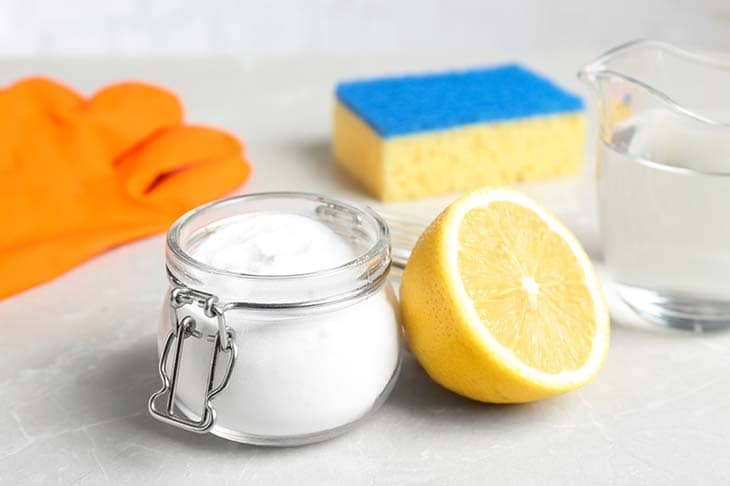
It might be best to stay away from dark colors unless you’re able to test an inconspicuous spot before applying it all over.
If you would like to take the power of lemons and make it even more effective, add a little bit of baking soda into the lemon juice mixture. Let it sit on the stain the same way you would if it were just lemon juice, and proceed from there.
Hydrogen peroxide
Hydrogen peroxide also acts as a bleaching agent, and it has the ability to get rid of some of those unsightly yellow sweat and deodorant stains on your shirt. The bleaching power of peroxide is stronger when you apply it straight.
So it’s a good idea to dilute it a bit before applying it to a light-colored shirt. You should start out with a mild mixture and increase the potency of your concoction if the stain isn’t going away as much as you would like.
Mix together ½ cup of peroxide with two full cups of water to start out. Dab it lightly on the stain, letting it sit for twenty minutes before washing it. Don’t dry your shirt until you’ve determined that the stain has been removed and you’re positive you won’t need to reapply a stronger hydrogen peroxide mixture.
Aspirin
Aspirin is incredibly affordable, and you may already have some sitting in your medicine cabinet. It has the potential to remove sweat and deodorant stains from your clothing, leaving them sparkly clean.
Take about five aspirin tablets and crush them up really well. Add them to a large bowl and fill the bowl with warm water. Mix the aspirin into the water until it has dissolved. Place your shirt in the mixture and let it sit for thirty minutes.
All you need to do is wring the moisture out of the shirt and put it right into the washing machine. You can repeat the process as needed, but aspirin can whiten and brighten your clothing.
Stain remover
If you don’t want to try a home remedy for the removal of your sweat stains, you can choose to purchase a store-bought stain remover product. You can choose from many; just make sure that you read the instructions completely before using them. There may be rules regarding the color of fabric that you should apply it to, how long you should leave it on, etc.
The most convenient stain remover products on the market come in stick form. You twist the product up like you would deodorant and apply it to the area of your shirt that is stained. It’s typically to leave the product on for a couple of hours before washing it.
Use OxyClean Products
OxyClean products are designed to remove tough stains from your clothing while getting them nice and clean. You can choose from a few different varieties, including stain remover products. It contains Sodium carbonate, which is a super cleaning agent. You can mix these products with vinegar to maximize their potential.
Products Designed for Deodorant Removal
There are stain remover products, but there are also products that you can purchase which are intended for deodorant stains specifically. Some of the more organic and natural products contain citrus to naturally remove the stains.
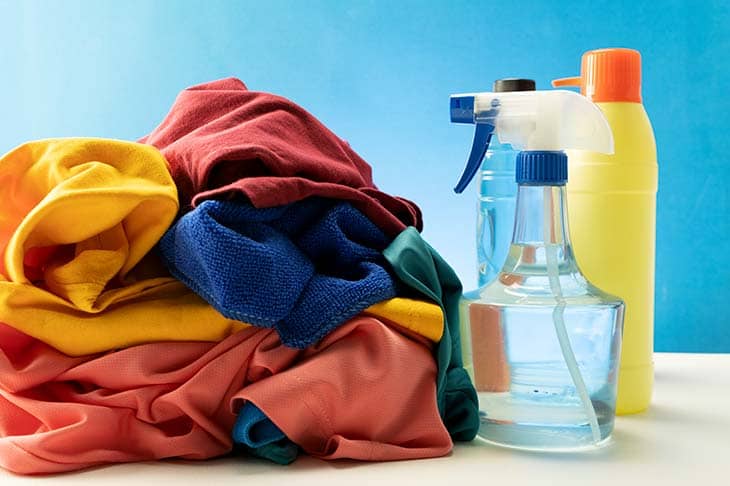
Others contain peroxide and some of the other ingredients that we’ve talked about in this article. Always read the instructions before applying them to your shirt. Certain ingredients can bleach or discolor your clothing if you’re not using it properly.
Now that you’re well educated on what causes sweat stains on shirts and deodorant stains, you can do something about those pesky stains so that they don’t completely ruin your wardrobe.
Don’t forget; you can try changing up the antiperspirant and deodorant products that you use each day as well. There may be certain ones that react more appropriately with your body when you perspire, so stains don’t become an annoying problem that you have to frequently deal with.
How to get pit stains out of shirts once and for all
Have you been dealing with pit stains on your shirts for long enough? Are you sick of throwing away clothing just because of underarm stains? Whether your sweat is to blame or your deodorant and antiperspirant products are causing the problem, we’re going to talk about different methods of removing these stains once and for all.
Armpit stains on shirts are something that a lot of people deal with but not many talk about. It’s an embarrassing issue, but there are ways that you can address the problem so that your clothes look fresher, cleaner, and stay new longer.
You may want to think about changing your products if they are causing the discoloration, but sometimes sweat just reacts a certain way which results in stains.
There are products you can purchase to address pit stains, but you can also use a number of home remedies to get rid of these unsightly spots.
We’re going to take a close look at what’s causing these stains, as well as what you can do to remove them and prevent them. We’ll even talk about what you should avoid doing in order to prevent the problem from becoming worse.
Why do pit stains become yellow?
Pit stains on light-colored clothing are usually yellow in color. Some people experience very yellow pit stains, while others notice just a light outline where the sweat was on the clothing. What causes these stains to become yellow? There’s a very simple answer.
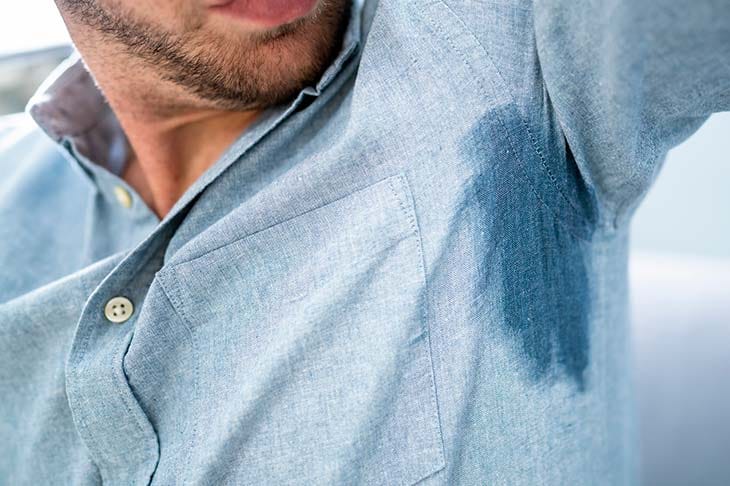
When sweat accumulates in our sweat glands, it will eventually be released. The sweat that comes out of your body will mix together with the deodorant that you’re wearing.
This causes a reaction that results in yellow pit stains. You can stop wearing deodorant and antiperspirant to prevent the stains, but then you might be dealing with a much smellier problem all together.
There are certain products that are more likely to cause this chemical reaction. You can experiment with a few different items to see if there’s something that works best for you. Every person’s body will react differently, so it comes down to figuring out what your best option is.
You can look for a deodorant that specifically advertises that its product won’t cause stains. Many of the newer all-natural deodorants are more likely to cause discoloration on your clothes because of the oils and ingredients that they use.
Can you use bleach on pit stains?
Bleach is often considered as a fix-all for stains, but it’s not always the best option. When it comes to white clothing with yellow pit stains, bleach can actually make the problem worse. Bleach has a low pH level, which can interact with the pH of your sweat and the stains.
If you need to remove yellow stains from a white shirt, there are better options that won’t alter the brightness of your clothing. An OxiClean product is designed with a precise pH level that will quickly remove stains without damaging your clothing. You can also use some of the other remedies that we’re going to talk about below.
How do you remove pit stains from clothes before they set?
The best choice that you have in regard to pit stains is to remove the stain before it sets into the fabric. As time goes on and you don’t address the stain, it’s going to become harder and harder to remove it.
When you arrive home and notice that you have sweat stains on your clothing, take a moment to at least pre-treat the article before you proceed with your day. Many products can be left on your clothing until it’s time to wash them.
In most cases, the product actually becomes more effective the longer you leave it on. However, always check the instructions of your stain remover to ensure there isn’t a time frame that you need to adhere to in order to prevent permanent damage to your clothing.
If you don’t have any store-bought stain remover on hand, you can mix together one part baking soda, one part hydrogen peroxide, and one part water. Mix all of the ingredient together thoroughly before soaking your entire shirt into the mixture.
You can also apply it just onto the armpit area of your shirt. If you are prone to pit stains, think about putting this concoction into a spray bottle. You can leave it in your laundry room and apply it to your pit stains whenever they occur.
Just be careful with anything that contains peroxide. Hydrogen peroxide has natural bleaching effects that can ruin your clothing if you’re not careful. Even a white shirt can become discolored if you apply too much or don’t rinse it out in time.
How to get rid of armpit stains
If you have a stubborn armpit stain on your clothing that you just can’t seem to get out with a normal washing, we have some simple tips that will help you clean your clothing with ease.
Whether you’re dealing with stains caused by sweat or stains that have occurred because of a chemical reaction between your sweat and the products you’re wearing under your arms, these methods should work well.
Use white vinegar
White vinegar is an excellent option for removing pit stains, thanks to its acidic nature. Your sweat has more of an acidic composition, and adding more acid to those sweat stains will actually help to break them down out of the fabric.
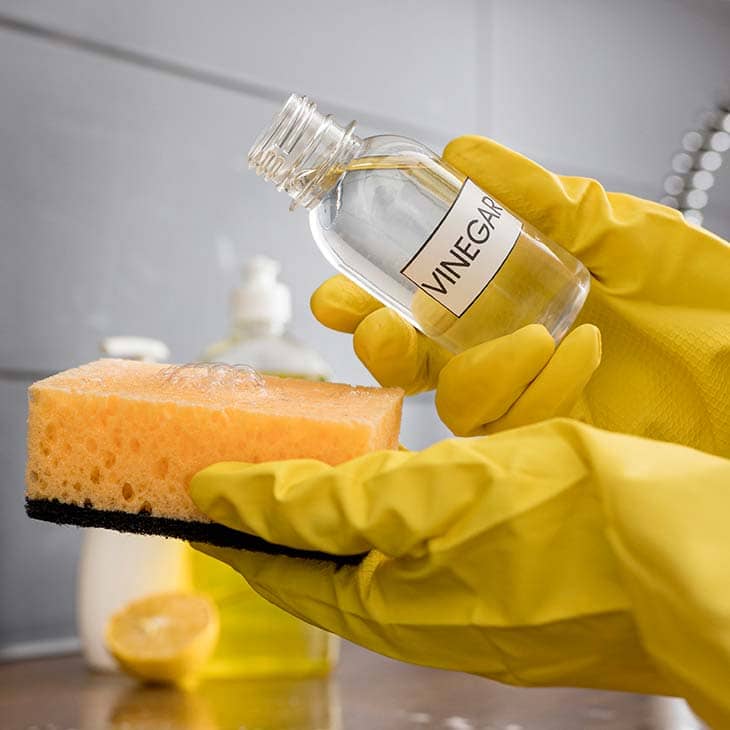
You can apply vinegar to your clothing directly, but more delicate materials may benefit from having vinegar diluted into a fifty/fifty mixture before applying. If you’re using straight vinegar, you can spray it or apply it right to the stain.
It also helps to make a water and vinegar mixture in a large bowl. Place your entire shirt in the bowl and let it soak for thirty minutes at a time. Wring out the excess moisture and place the clothing in your washing machine. Run it on a normal wash cycle with detergent before allowing it to hang dry. Repeat the process as needed.
If the stain persists, try with hydrogen peroxide
If you find that your sweat stains are persisting on your clothing, you can repeat the process that you previously used if it looks like some fading did occur. You may want to step things up a notch and use a stronger stain removal process.
Hydrogen peroxide added to your vinegar and water mixture is a great option, or you can just stick with hydrogen peroxide and water mixed together. This mixture can also be sprayed onto your clothing, or you can let your shirt soak in it for thirty minutes.
Make sure you rinse the item out completely before putting it into the wash to prevent bleaching from occurring to your other items. If you can’t wash the item at the moment, make sure you rinse it until you can get to it later on.
Use laundry detergent
Laundry detergent comes in all different varieties, many of which have stain-fighting properties. Choose a detergent that advertises its ability to get your clothing ultra-clean while removing any tough stains.
There are some strong products out there that are able to remove some pretty nasty stains involving blood, wine, coffee, tea, and grass.
Place the recommended amount of detergent into the bottom of your washing machine’s basin. Run the wash cycle on cold, adding your shirt to the cycle.
If your washing machine allows, set the soak cycle to a minimum of 15 minutes. This will allow the detergent plenty of time to soak into the stain and remove them before rinsing.
Use a toothbrush to remove the stain
A little bit of elbow grease goes a long way when it comes to stain removal. Some fabrics are very tightly woven together, which allows for stains to really settle into the depths of the fabric.
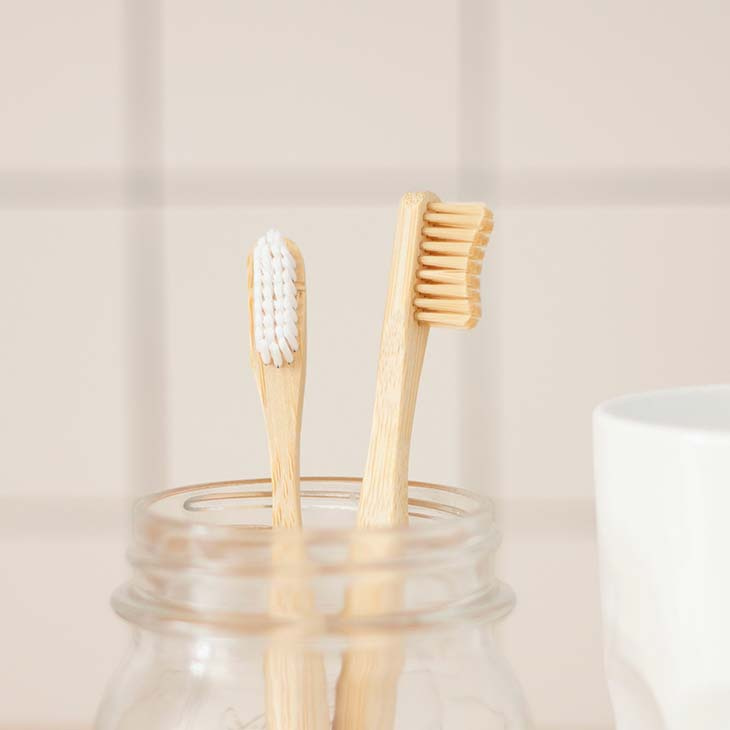
If you use a soft brush like a toothbrush to scrub lightly at the stain, this can help you save some of your favorite clothing items. Don’t rub too hard, and use extreme caution if you’re working with a delicate fabric. You can end up stretching out the fabric, causing pilling, or wearing a hole into the fabric if you’re not careful.
Let it sit for about an hour
When you apply a stain remover to your clothing, you need to give it enough time to do its job. You’re not going to be able to effectively remove a stain if you apply a product and then immediately wash it out.
A general rule of thumb is to let stain remover sit on your clothing for at least thirty minutes to an hour. At that point, you can rinse or wash the item and see if anything has changed. If not, you can repeat the process as needed or try something stronger.
Wash it in cold water
If you attempt to use hot water on a stain, it can actually cause the stain to spread and set into the fabric more. The best temperature to use is cold water because it stops a stain in its tracks. You’ll be able to address the problem without having to worry about things getting worse or the stain taking up a larger area than it did before.
Air Dry Your Clothing
Never put an article of clothing into the dryer on a heat setting if you’re not completely sure that the stain has been removed. The drier can cause the stain to become more persistent.
If you need to wash it or treat it again, you could be stuck with a stain that can no longer be removed. Hang your clothing up to air dry. If you really need to dry it quickly, place it in your drier on a drying rack with a cool air setting.
Lemon Juice
Lemon juice is a great natural stain remover that works very similarly to vinegar because of its acidic pH level. You can literally cut a lemon in half and use the open side to scrub lightly at your pit stains before letting the shirt sit for about an hour. You can also squeeze some lemon juice into your vinegar and water mixture to make it more effective.
Try Dish Soap
It might seem silly when you already have laundry detergent in your laundry room, but dish soap can actually work really well to get out stains. Dish soap usually has grease-fighting properties that help get your dishes clean.
But it can also work some of that oil and grease out of the armpits of your clothing that are being caused by deodorant products. Make a mixture of dish soap and water (equal parts) and let your shirt soak in that mixture. Stay away from those dark-colored dish soaps that have artificial coloring in them. They could end up staining your clothing.
Turn the Item Inside Out
It’s likely that the pit stains on your shirt originated on the inside of your shirt. Attack the stain from the inside of the shirt to get the best results. You can also treat it from the outside as well to really get into those inner fibers.
Now that you have a large selection of stain removal tips to use to get your clothing clean, get ready to tackle those pit stains. If you have the necessary items on hand, you’ll be able to make quick work of an armpit mess as soon as it occurs. Stick with us to learn how to address those stains that end up around the collar of your light-colored dress shirts.
How do you remove ring-around-the-collar stains
Stains that occur around the collar of your shirt are usually caused by sweat. When you have that stiff collar, it makes close contact with your skin. Over time that sweat will build up, creating a stain that can be hard to remove.
You may find that your dress shirts are only lasting about half the amount of time that they should be before you have to replace them. Not to mention, ring-around-the-collar stains can be embarrassing.
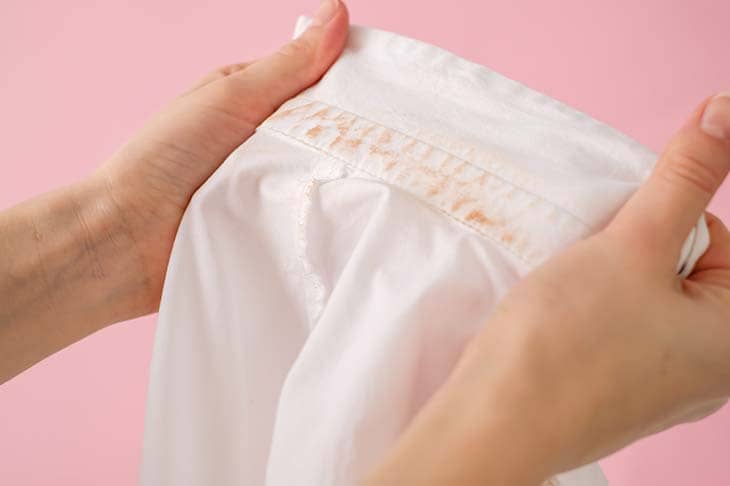
In chapter five, we are going to be talking about effective ways that you can get sweat stains out of the collars of your shirts. Some stains will be easier to remove (especially if they’re new stains), but we have different options based on the severity of your stains.
Don’t be afraid to try a couple of different remedies if you’re not getting the results that you’re looking for.
The reason your collar stains are tough to clean is that they are caused by a buildup of sweat and oil from your skin. As those substances get pushed deep down into the fabric of your shirt, it becomes very difficult to just wash them out with a regular run through your washing machine. The longer you leave it untreated, the harder it will be to take care of.
Let’s take a look at our tips for removing sweat stains from the collar of your shirts.
Rinse the garment of clothing in cold water
Always stay away from hot water when you’re trying to remove a stain from your clothing. If you were to clean a ring-around-the-collar stain using very warm or hot water, this could lead to the stain spreading.
It’s best to choose cold water for this process. Cold water works well for all kinds of stains, and you’ll be able to address stains caused by sweat, oil, makeup, and other substances if you’re using a versatile water temperature.
Pre-treat it with detergent or a stain remover spray
Using a pre-treatment product on your clothing gives you a head start on stain removal. These products are designed to start breaking down the stain before you come along to scrub or wash the area. Ingredients will help dissolve and loosen up the different oils and components that are deep in the fabric’s fibers.
Stain remover sprays should be applied and left on a stain for at least twenty to thirty minutes but check the product’s instructions to be sure. If you don’t have anything on hand that’s designed for stains, you can apply a little bit of detergent to the spot. Let the soap sit for twenty minutes, and then add the shirt to your normal wash cycle.
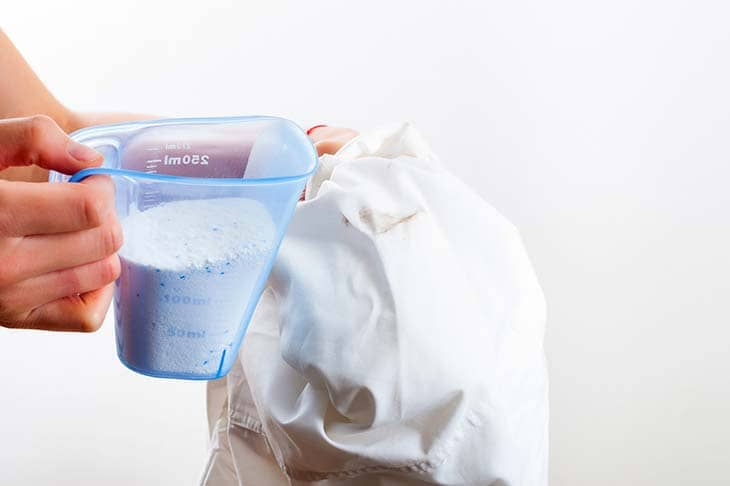
Let it sit for 20 min or more, depending on the stain
Most stains will respond to treatments that are left on for at least twenty minutes. If you have a little more time to work with and you know that extra time isn’t going to damage the fabric of your shirt, feel free to leave it longer.
Suppose you have a dark ring-around-the-collar stain that is dark yellow or almost brown; the more time you have to leave the treatment, the better. Some products can be applied and left on your shirt overnight. You can wash it normally when you get around to running your next load of wash.
Wash the garment in the washing machine
Hand washing your stained shirt isn’t going to be effective enough. You’ll want to treat the item and then eventually run it through your washing machine. The machine will run through cycles that are designed to get your clothes very clean. You can also change the settings on your machine to increase the effectiveness of the wash.
Choose cold water and select a 15-to-30-minute soak if your washing machine has that feature. A double rinse is a good option as well if you have a lot of stain remover or detergent on your clothing. You can use the delicate wash cycle for expensive and delicate materials.
Check the label before selecting the cycle
Always check the care label on your shirt before using any kind of product on it. You should also see how it needs to be washed to prevent damage. Follow the wash instructions carefully.
Repeat the process if necessary
Not all stains are going to come out of your shirt’s collar right away. You may notice that the stain has faded a bit with the process you used, but you may need to repeat the process a few times to see optimal results. Don’t become discouraged if this happens.
The goal is to gently remove the stain without damaging the fabric, which can take time. You can repeat the same process if you saw good results, but trying a different treatment option may be what you need to fully get the stain out.
Let it dry
Let your shirt air dry before you determine if the stain has been removed. A wet article of clothing may look perfectly clean, whereas there’s actually a stain present that should still be addressed. If you were to dry the article of clothing in your drier, then that heat could cause the stain to set in even more. You could end up ruining your shirt forever.
Try Dish Detergent
For extremely greasy ring-around-the-collar stains, consider using dish soap. Dish detergent for collar stains can quickly break down the residue that’s on the fabric before you run it through your washing machine. You can fill up a large bowl or bucket with a cap full of dish soap and cold water.

Let the shirt soak in the mixture for about an hour before you wring it out and run it through a wash cycle. You can also apply dish soap directly to the collar as a stain remover. Just make sure that you’re not using dish soap with a colorant added to it. This would further stain your light-colored dress shirts.
Agitate the Stain
The goal is to get your stain remover or detergent deep into the fabric of your shirt’s collar so it can do its job. Apply whatever product that you’re using and use a soft brush or toothbrush to lightly scrub the area. After doing this, let the product sit on the shirt for at least another 20 minutes before washing it off.
Head to the Dry Cleaner
You may need to use the services of a professional if all else fails and you can’t get the stains out of the collars of your shirts. Dry cleaners have strong products that may be able to remove stains that you weren’t able to take care of.
Prevention is Key
Don’t forget to prevent your sweat stains in the future. It’s a good idea to get used to a regular washing schedule. Washing your shirts before stains set in is optimal. You can also apply a stain removing product to the shirt and let it sit until you are able to wash the article of clothing.
These tips are very effective and should help you with any ring-around-the-collar stains that you have on your shirts right now. If you’re prone to this issue, there are some changes you can make to prevent these sweat stains from setting into the fabric of your wardrobe.
Conclusion
Now that you know more about why sweat stains form on your clothing and what you can do to prevent and treat them, you’ll be able to tackle your dirty laundry more effectively. This means that you’ll be able to save some of your old articles of clothing before they’re ruined and need to be tossed out.
If you have any questions about cleaning sweat stains out of your shirts or would like to share how you got rid of your sweat stains, comment below. You can also read some of our other posts to learn more about how you can take care of other articles of clothing and other style and fashion information.
